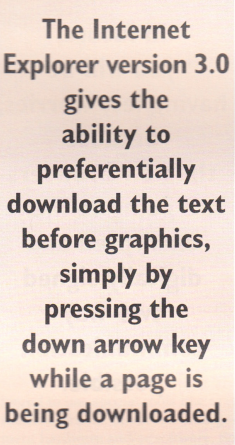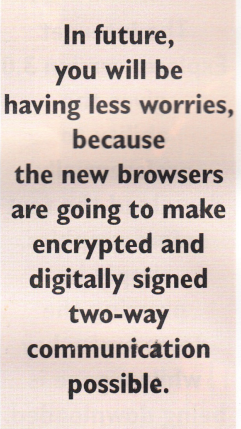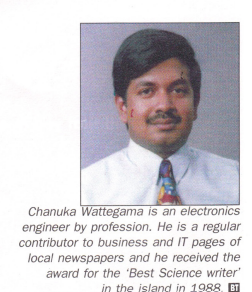‘First looks at the new versions of the Netscape and Microsoft Web Browsers.
It is a well known fact (though no one accepts it in public!) that those who are involved in the Computer Industry have some weird characteristics. For everyone else, 1996 was just the last year. For the Information Technology professionals it was the last decade, if not, the last century! It was just a few months back, to be exact in November 1996, that the Technical Editor of the PC Magazine (UK) Rupert Goodwins had ‘first looks’ at the latest advanced versions of the two popular Web Browsers Netscape Navigator and Internet Explorer, taking them side by side. And now, believe it or not, we hear that the day that we are going to have the last looks’ of them is not very far!
Both Netscape and Microsoft, the key players in the web browser field, are going to introduce the new versions of their web browsers with some remarkably fascinating features, shortly. Perhaps, the beta versions of them could be downloaded from the web by the time you read this. Meanwhile, please note, one hundred and one less popular browsers hit the market regularly.
Browsers need no introduction to the regular Internet surfers, but only few know the real contribution they made towards making the net what it is today. Browsers are directly responsible for the exponential growth of the Internet,
and more particularly, the world wide web. Browsers have not only made the web accessible to everyone, irrespective of the different hardware platforms they used, but have also made the process user- friendly so that even an eight year old kid could get the full benefit of the Information Super Highway. If not for them, the net would have remained a boring collection of data bases.
Browsers made news for the first time in September 1993. Mosaic, the first platform-independent browser was from the National Center for Supercomputing Applications (NCSA) and it worked equally well on Unix. Windows and Mackintosh environments. It could only retrieve text and static imaCes from the cyber space but this was considered a marvel compared to the cumbersome tools used at that time. The predecessors earn up with more and more significant features, First, they made it possible to include audio and video clippings to the dumb web pages to make them more appealing. Then, they included features such as e- mailing, file transferring, net searching and web conferencing utilities. Later, they provided browsers with the ability to run down loaded Java applets and in the latest versions you can even upload your home page to the web server which will ‘publish’ it in turn. It is interesting to note how far the browser developers had gone to deliver the very best for their users. For instance. the Internet Explorer version 3.0 gives the ability to preferentially download the text before graphics, simply by pressing the down arrow key while a page is being downloaded. The Sri Lankan users specially, who have to spend longer time periods before their terminals, because of the telecommunication limitations, are sure to benefit by the introduction Of such a feature. So what could we ask for? Aren’t they giving us everything
that we ever wanted and more? These were the questions which sprang to my mind when I saw an article on Netscape’s current attempts to change the face of the Navigator. the most commonly found browser worldwide, to an Internet-enabled groupware program. in the 1997 March issue of the ‘Byte’ Somehow, when I read on. I understood how
wrong I had been. There is plenty of room for the browsers to grow. The only thing is that we never believed it was possible for them to deliver such wonders, and so we never expected them to do so accordingly. This is, in spite Of the fact that we face numerous limitations while using them.

The frequent surfers of the Net might be quite conversant with the limitations of the present versions.
Even I, who rarely find time to do a proper surfing have faced some of them. I find the stumbling blocks particularly in the e-mail- ink. It has come a long way since the days of non-lnternet mailing, but still it lacks some of the advantages of snail-mail, This real life ease illustrates the point well. One of my university batch mates in Ahmedabad, with whom I communicate regularly through e-mail, wanted to see my wedding photographs, Surprisingly, I had no other option than sending them through snail-mail. Of course, I could have scanned them and sent them attached to the mails as BMP (bitmap) files, but my friend is not a seasoned computer user and he says he does not know even how to view a GIF file. How nice it would be if I could send the photographs embedded to the letter itself, so that he ean see it without any extra effort?
Well, Netxperts who know ways to make anything possible may come up with an answer for this too, but most certainly it will be neither simple nor cheap. One possibility is to include a link in the e-mail which leads to a web page with the photographs. This is also possible because the current e-mail tools, unlike their predecessors. support hyper-text links and a click on it will enable the user to open a new web page. However, what we need is not that. What an average user expects is the ability to include the photographs and other important documents in e- mail with the same ease with which they put them into an envelope. This is exactly what the new browsers do. ‘Byte’s’ optimistic technical manager Jon Udell expects us to send plenty of graphic makes in e-mail before the end of this year. This means you need not bother searching for words to describe how brilliantly Aravinda hit a sixer, to a friend living in London. You can send him the video clipping itself without any difficulty.
Another possible domain that a browser can develop is in its multilingual support. Perhaps you might have seen the claims of some local Internet service providers that they could provide you with the facility of creating and browsing the web pages in Sinhala or Tamil. What they do not tell are the stipulations attached to it. Using a local language in the Internet environment is not as straightforward as using English or French. The creation of the web pages, of course, is easy- you just have to use a good Sinhala/Tamil Font in place of English-but if anyone wants to view those web pages he/ she has to download the proper set of fonts before doing that. This is because the browsers support a limited number of languages and understandably both Sinhala and Tamil are not in the list of the supported languages. The consequences of this are two-fold. First, the viewer has to download the appropriate set of fonts and install them in his/her machine. This will take 15-30 minutes even for a well acquainted user, and I won’t be surprised if a less trained user gives up the idea of visiting the website entirely. Second, it can only be done in IBM compatible machines, at least until the moment of writing this. No Unix work stations or Apple Mackintosh computers, please.
Last year, Accent Software International came up with a partial solution. The company’s main product, called ‘Internet with an Accent’ which was somewhat equivalent to a multilingual version of Mosaic, supports 25 different languages. The list of fonts it supports include many non-Ro- man fonts like Davidfix (Hebrew) and Maliklight (Arabic). It also knows to reverse the text direction whereever appropriate. (This was one of its most remarkable features and without it, the support for languages like Arabic would have been obviously useless). An on-screen button makes the swap between the languages a kid’s play but even in this browser the menus and submenus remain only in English, perhaps because the developers assumed that if anybody has come up to the level of browsing and creating web pages he should well understand the basic commands in English. Netscape and Microsoft on the other hand, did not have such assumptions when they made several non-English versions of these browsers available online. However, these versions cannot support more than one language at a time.

Another drawback, the current versions of the browsers have is the security, or rather the lack of it. You are forgiven for thinking twice before using an Internet Banking system, or an electronic mail ordering system. For transaction processing purposes, a secure two-way link has to be established, acknowledged and maintained throughout the transaction, and no browser today can achieve it. This is why they warn you that it is not impossible for a third party to view the data you enter into a form.
In future, you will be having less worries, because the new browsers are going to make encrypted and digitally signed two- way communication possible. ‘Encryption’ means that only the person who is intended to read the message and no one else can read it. The famous public-private key encryption technique comes in handy here. So, the sender of a message scrambles it using the receiver’s ‘public key’ and the receiver can unscramble it using his (receiver’s) private key. Digital signature confirms the identity of the sender. The sender can attach a digest of the message that’s been scrambled with his (sender’s) private key. The receiver’s system can unscramble the digest using the senders’ private key and generate a fresh message digest. If the two digests match, the signature checks. In fact this is not some- thing new. Lotus Notes users have been able to do these things for years. What’s new is the notion of inviting millions of Internet users to routinely apply public-key cryptographic methods. It will eventually take away the suspicion of someone else peeping into their confidential data from the users’ heads.
This scenario raises two challenges. The first one is the infrastructure challenge. Who will operate a system in which we can look up each others’ certificates and keys? Who will manage the certificate authorities that bind public keys to the identities? What guarantee do we have that these people themselves will not reveal our data to another party? These questions should be given satisfactory answers before we proceed any further.
The second challenge is to train users, though it will not be as difficult as it seems. The only thing freshly introduced will be the use of cryptographic keys and certificates. All the rest will be the same. While typing URLs (Universal Resource Locaters) instead of typing ‘http:// you are required to type ‘https:// (the ‘s’ stands for secure http). Thereafter all your security concerns will be looked after by the browser. The iconic key disappears, a blue border appears and you can type your credit card number into a Enter secure form, with a trouble- free mind.
The recent developments in the browsers may also open a path so far never explored, but it is too early to discuss about it in detail. Many computer magazines have published lengthy and descriptive articles relating to this subject recently and it is not difficult to find more information. You will really be surprised to find how closely various other topics like Java, Network computers (NCs), extranet, client server computing etc., are all related with the advancements of browsers. Perhaps in another few months we will also be able to observe how the developments in all these subject areas would lead towards a common goal.
I would like to conclude with an interesting item. The browser software developers have not left out even the smallest groups of specific users. At present, the number of either blind or visually impaired users have grown to a few thousands. Since it is never possible for them to browse the web in the normal way, they are forced to use special tools like text readers, braille, or screen enlargement hardware and/or software. So far, most of these adaptive utilities came from different vendors and as a result many compatibility problems had to be encountered. The latest trends are either to present browsers inclusive of all these features or to develop small modules which can be ‘plugged’ to the browser effortlessly.
A software company called Productivity Works’ has recently introduced a special web browser WebSpeak’ only for blind users. This browser has its own built-in speech processor and does not require a separate screen reader program. The browser passes a web page’s HTML (Hypertext Markup Language) code to present the information in a more speech- friendly manner. It can also drive a variety of speech synthesizers, including the Sound Blaster voice card.



